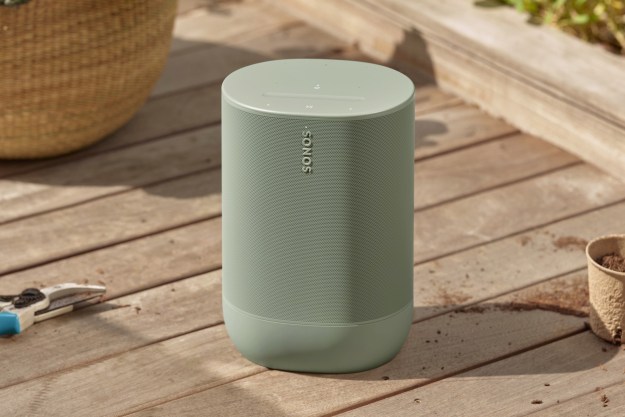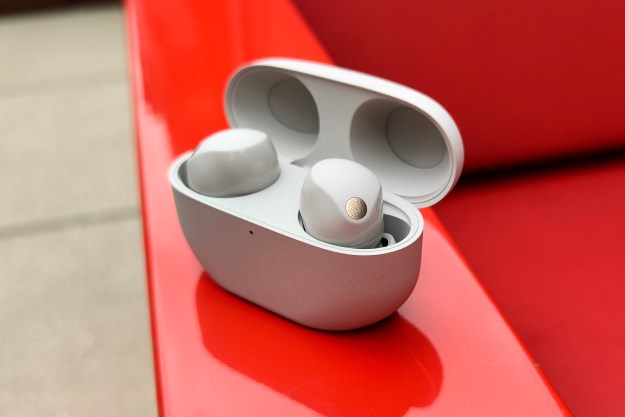We at Digital Trends are more fortunate than most in that we get to sample hundreds of wireless speakers each year, separating the wheat from the chaff and drilling down to those products worth owning. And yet, even we grow weary of the dizzying amount of options out there. Who can keep up with all these brands? Which ones have just the right blend of features and sound quality? Which company is doing something special to break through all this noise? The fact that we’re writing a Vava Voom 22 review should tell you something: These speakers are worth a serious look.
Out of the box
As soon as you pull a Vava Voom 22 speaker from its box, you understand why it won a Red Dot Design Award. These speakers are easy on the eyes and constructed in simple, yet effective ways.
First looks tend to zoom in on the Voom 22’s modest statuesque presence, smooth grey grill material, and minimalist control button layout. A closer inspection reveals a 5V/1A USB charging port to power devices and a 3.5 mm jack for wired connection to nearly any source – and that might just include a TV, or a turntable with built-in pre-amp, for starters.
The top of the speaker is graced with a series of useful touch-capacitive control keys for power, Bluetooth pairing, track advance and reverse, volume up and down, play/pause, and bass boost (left to right).
The speaker feels a little lighter than we expected. At 3.9 pounds it doesn’t strike us as especially robust in the build quality department, but then again, we’ve heard plenty of quality speakers that didn’t feel like gold bricks when picked up.
Under the hood
Vava is keen on pointing out that the Voom 22 speaker features subwoofer with its own 20-watt amp, but it seems to function as a mid-bass driver, with a .75-inch tweeter powered by a 10-watt amplifier handling upper mids and trebls. In total, that’s 30 watts of digital amplification for one speaker. Buy a pair (and we’re going to suggest you do just that) and you’re up to 60-watts power for a stereo system.
The Voom 22 is easy on the eyes and constructed in simple, yet effective ways.
The specs hint at prodigious bass production, and as we move toward setup, we’re thinking that, with the right DSP equalization, that could well be possible. There’s ample cabinet space, and a port on the rear hints that designing these speakers around sounding full and robust was one of Vava’s chief goals.
Finally – and this is why Vava can call the Voom 22 a “truly wireless speaker” – we call attention to the built-in battery, which the company says will allow the speaker to play for approximately 4-6 hours based on usage. In other words, you’ll get about four hours if you play the speaker loudly, and closer to 6 if you listen at more moderate volumes. A speaker will also drain faster if you use it to charge a phone, tablet, or other USB-powered device like an Amazon Echo Dot.
Setup
Setting up the Vava Voom 22 speakers is as easy and automatic as it gets. Turn the speaker on and it is in pairing mode – just grab your device and choose the speaker as you desired audio output device.
It is when you add a second Voom 22 speaker that things get even easier for you. If you want to join the two speakers so that one is a right channel and the other a left channel as part of a stereo pair, simply turn on the second speaker. The two speakers will detect each other and one will take over the right channel while the other will handle the left channel duties. To go back to mono, simply turn one of the speakers off. You can always keep the speakers in separate rooms and use them independently, too.
You’ll get about four hours if you play the speaker loud, and closer to 6 if you listen at more moderate volumes.
This is a huge step in the right direction. Often, a special app and some mix of voodoo and prayer is necessary to pair two wireless speakers in stereo. One issue that this simple setup doesn’t appear to address, though, is allowing user control of which speaker will take on which channel.
To determine which speaker is right and which is left in a stereo pair, look to the LED indicator lights to the left of the power button on each speaker. The speaker with the blinking LED will be the left channel, and the speaker with the solid LED will be the right. If you think you’re going to have trouble remembering this, we’d suggest pulling up this stereo channel test video on YouTube to determine which speaker is right, and which speaker is left, and adjust placement as necessary.
Speaking of placement: These speakers behave very much like a quality set of bookshelf speakers when placed in stereo mode. You’ll want to play around with how far away they are from walls behind them, as this can affect bass response, and you’ll want to space them evenly apart, and about as far apart as you sit from them for the best imaging. We also suggest putting them on the edge of the surface they sit on to reduce sonic reflections.
Performance
In a nutshell, the Vava Voom 22 performs far beyond what we expect from a speaker in this price class. At $130 for a single speaker, the Voom 22 is already a killer deal, but Vava offers a pair of the speakers for $220 – that’s $40 in savings – and that’s pretty much a slam dunk in our book.
For our Vava Voom 22 review, we used Spotify (high quality audio enabled) exclusively and began by operating a single speaker. We were surprisingly not bowled over by bass – and that’s a good thing. Bass was present but not overpowering, and the sound quality was balanced even at low volumes. For those looking for light background music playback, the Voom 22 will work quite well.
We then pushed the Voom 22 a bit to see how it performed at slightly higher volumes. We were thinking party time here, so we engaged the bass boost feature and – whoa! – the bass sprung to life. At this point we got a decent dose of punch, with plenty of low frequency resonance. This speaker most certainly fills up a room, and fares well in outdoor entertainment scenarios.
Vava claims extension down to 60Hz, but we clocked the speakers rolling off closer to 80Hz in most conditions. We were able to enhance extreme low frequencies a bit by placing the speaker in a corner, but then we also got a little bit of muddiness coming into play. We preferred a slightly more open placement in general throughout our evaluation.
Next, we added a second Voom 22 for stereo music listening and placed the speakers on speaker stands as we would for a high-end bookshelf speaker or powered monitor review. It was at this point we were sold on having two speakers for more attentive listening. We were pleased with the pair of Voom 22’s imagine and sound stage, with clear stereo effects, a contiguous soundtage from left to right, and placement of instruments at specific points within that soundstage.
In stereo mode, we felt less need for the bass boost as the doubling of bass frequencies helped enhance the musicality of the speakers. However, when we decided we wanted to jam, engaging the bass boost brought a smile to our face. The speakers sound incredibly full, especially for the price.
The Voom 22 aren’t perfect speakers, however. We did notice some occasional stereo phasing as sounds seems to move out of the right channel and into the left where they didn’t belong, then back to the right. This was only noticeable when we sat down right in front of the speakers for our most intent and critical listening, but it was a regular occurring issue. We believe this to be a side effect of wireless stereo pairing and are discussing the issue with Vava.
Setting up the Vava Voom 22 speakers is as easy and automatic as it gets.
Additionally, if we’re putting our our picky audiophile hat, we have to say that the Voom 22’s speaker cabinets audibly resonate when played loud or with heavy bass, coloring the sound a bit. Also, there’s something going on in the upper midrange that’s a little grating. We noticed some vocal tracks came across a little aggressive, and crunchy distorted guitar was too forward for our liking. Surprisingly, we were less aware of this effect with brass instruments, where we expected it might be especially present.
With those criticisms voiced, we don’t think most listeners will have a problem with these picky issues. These speakers are targeted at audiophiles – they just happen to perform so well that they earned our toughest critique.
Conlusion
Overall, the Vava Voom 22 performs extremely well for the price. Their dead simple setup, robust sound, impressive loudness (volume level), and gorgeous looks make them worthy of serious considerations. Frankly, the Vava Voom 22 are an incredibly good deal – especially in a stereo pair.
Editors' Recommendations
- Sony’s ULT Power Sound headphones and speakers go big on powerful bass
- Best wireless speakers for 2024: Sonos, JBL, KEF, and more
- IP what? Explaining water and dust resistance for audio gear
- B&O’s latest speaker is a love letter to aluminum
- Tivoli Audio’s Model Two Digital speaker abandons terrestrial radio









